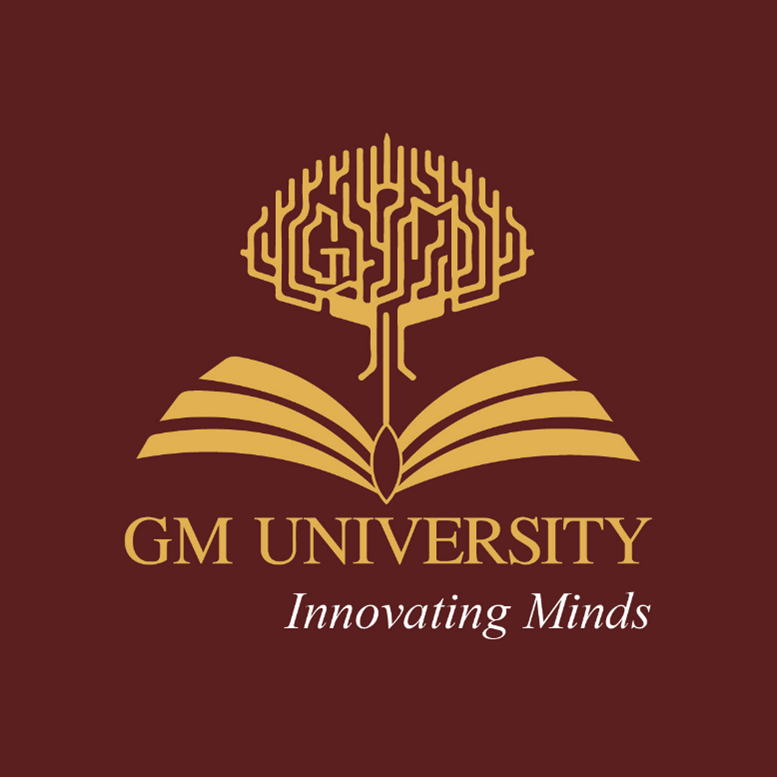- About Us
- Introduction
- Srishyla Educational Trust
- G M University
- GMU- Campus
- GMU Logo, Flag and Mascot
- GMU- Anthem
- Vision, Mission, Values, and Objectives
- Leadership
- Statutory Committees
- University Documents
- Organisation Structure
- University Best Practices
- Information and Communication Technology (ICT)
- Learning Management System (LMS)
- Human Resources (HR)
- Collaboration and Cooperation
- Programs
- Admissions
- Academics
- Research
- Introduction
- Research Advisor Message
- Dean's Message
- PhD Programs offered &
PhD Regulations - Notifications &
Circulars - Galary
- Curriculum
- PhD Admissions
- PhD Supervisors
- PhD Research Scholar List
- Journal Publications
- Conference Publications
- Conferences/Symposium Organized
- Patents
- Research Bulletin
- Sponsored/Grant Research
- Prestigious Lecture Series
- Centres of Excellence
- Skill Development
- Home About Us
- Introduction
- Srishyla Educational Trust
- G M University
- GMU- Campus
- GMU Logo, Flag and Mascot
- GMU- Anthem
- Vision, Mission, Values, and Objectives
- Leadership
- Statutory Committees
- University Documents
- Organisation Structure
- University Best Practices
- Information and Communication Technology (ICT)
- Learning Management System (LMS)
- Human Resources (HR)
- Collaboration and Cooperation
- Programs
- Admissions
- Academics
- Campus life
- Promotions
- Student Placements
- Contact Us
- Careers
Keeping a teaching professional in a Dynamic State
The analogy between a professional in academics and a dynamic system highlights the risk of stagnation in teaching professionals as they progress in their careers. Initially, a new professor exhibits dynamic behaviour, adapting, innovating, and responding to challenges, akin to the transient phase of a system's response to a step input. However, as the professor gains experience and enters a steady state, they may settle into a routine, losing the drive for growth and innovation. The goal is to keep educators dynamic and engaged throughout their careers, avoiding the plateau of a static "steady state."
Here’s how to apply this system model concept to keep teaching professionals in the dynamic phase:
1. Continuous Learning and Development
In a system, the transient phase is where adaptation occurs. To maintain dynamism in educators, opportunities for continuous professional development should be provided. This could include:
- Workshops and Courses: Encourage faculty to regularly attend workshops, webinars, or advanced courses on new teaching methods, technologies, or subject knowledge. This ensures they constantly update their skill set.
- Higher Studies and Research: Motivating teachers to pursue further education or conduct research keeps their academic curiosity alive. Research provides new challenges, maintaining their engagement in dynamic learning.
2. Innovative Teaching Methods
In system control, keeping the input dynamic produces continual change. Similarly, teaching methods should evolve:
- Incorporating Technology: Encourage the use of AI tools, simulations, and interactive platforms that require constant learning and adaptation. For example, using AI for adaptive learning tools or data-driven teaching insights keeps the approach dynamic.
- Flipped Classrooms and Project-Based Learning: These methods shift the focus from traditional teaching to student-centered, interactive modes, which force teachers to stay engaged with both the content and the learning needs of students.
3. Feedback and Reflection
Feedback loops in a system can introduce new dynamics. Similarly, regular feedback from students, peers, and self-reflection pushes educators to identify areas of improvement:
- 360-Degree Feedback: Encourage an open culture of feedback where students, colleagues, and administrators provide constructive feedback on teaching methods.
- Peer Learning Groups: Faculty development through collaboration and sharing best practices keeps teachers engaged in new ideas and methodologies.
4. Mentorship and Collaboration
In control systems, coupling with other systems can generate new responses. Collaborating with colleagues across disciplines or mentoring younger faculty can reignite a professor’s passion and introduce new perspectives:
- Cross-Disciplinary Research: Collaborating on projects that span different fields encourages continuous learning and exposure to new concepts.
- Faculty Exchange Programs: Engaging in short-term teaching or research assignments at other institutions fosters new insights and dynamism.
5. Setting Challenging Goals
Systems remain dynamic when external stimuli change frequently. Setting new, ambitious goals for educators can ensure they never become complacent:
- Research Grants and Competitions: Encouraging faculty to apply for research funding or participate in national/international teaching competitions introduces new challenges and opportunities for growth.
- Performance Benchmarks: Offering incentives for faculty who exceed expectations in student engagement, innovative teaching, or research output keeps them motivated to stay dynamic.
6. Adapting to Student Needs
The academic environment is constantly changing, and student needs evolve over time. Teachers should be encouraged to:
- Customize Learning Experiences: Use data and feedback to tailor instruction to diverse student groups, forcing continuous innovation in teaching strategies.
- Lifelong Mentoring: Actively engage with students beyond the classroom, keeping the learning environment dynamic and fostering a sense of responsibility in educators.
By integrating these strategies into the professional development of teachers, institutions can ensure that educators remain in the dynamic phase of their careers, continuously growing and adapting like a well-tuned system that never reaches a static steady state. This prevents burnout and maintains their enthusiasm for teaching and learning.
